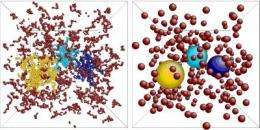Making complex fluids look simple

An international research team has successfully developed a widely applicable method for discovering the physical foundations of complex fluids for the first time. Researchers at the University of Vienna and University of Rome have developed a microscopic theory that describes the interactions between the various components of a complex polymer mixture. This approach has now been experimentally proven by physicists from Julich, who conducted neutron scattering experiments in Grenoble. The results have been published in the June issue of Physical Review Letters.
Some important materials from technology and nature are complex fluids: polymer melts for plastics production, mixtures of water, oil and amphiphiles, which can be found in both living cells and in your washing machine, or colloidal suspensions such as blood or dispersion paints. They are quite different from simple fluids consisting of small molecules, such as water, because they are made of mixtures of particles between a nanometre and a micrometre in size, and have a large number of so-called degrees of freedom. The latter include vibrations, movements of the functional groups of molecules or joint movements of several molecules. They can appear on widely varied length, time, and energy scales. This makes experimental and theoretical studies difficult and, so far, has impeded understanding of the properties of these systems and the targeted development of new materials with improved properties.
A method developed and tested by physicists at Forschungszentrum Jülich, the Institut Laue-Langevin in Grenoble, and the Universities of Vienna and Rome now permits realistic modelling of complex fluids for the first time. "Our microscopic theory describes the interactions between the various components of a complex mixture and in turn, enables us to draw realistic conclusions about their macroscopic properties, such as their structure or their flow properties," said Prof. Christos Likos of the University of Vienna, an expert on theory and simulation.
The team from Vienna and Rome developed the theory model. Since the researchers were unable to include all the details of the real system – a mixture of larger star-shaped polymers and smaller polymer chains – they systematically eliminated the rapidly moving degrees of freedom and focused on the relevant slow degrees of freedom, a time-consuming and challenging task. "To do this, we use a relatively new method called coarse graining and replace each complex macromolecule with a sphere of the appropriate size. The challenge involves integrating the degrees of freedom that have been eliminated in the simplified systems as averages so that the characteristics of the substances are retained," Likos explained.
The team from Jülich used elaborate small angle neutron scattering experiments with the instrument D11 at the Institut Laue-Langevin in Grenoble to prove that the interactions between the spheres of the coarse-grained model realistically simulate the conditions in the real system. "We were faced with the proverbial challenge of visualizing the needle in a haystack," explained Dr. Jörg Stellbrink, a physicist and neutron scattering expert at the Jülich Centre for Neutron Science (JCNS). For neutrons, the individual polymers of the mixture cannot be readily distinguished. For this reason, the physicists "coloured" the components they were interested in, so that they stood out of the crowd. This is one of the Jülich team's specialities. In this way, they were able to selectively examine the structures and interactions on a microscopic length scale.
The physicists are especially proud of the excellent agreement between theoretical predictions and experimental results. The method will now open up a spectrum of possibilities for studying the physical properties of a whole range of different complex mixtures.
More information: Ultrasoft Colloid/Polymer Mixtures: Structure and Phase Diagram; B. Lonetti, M. Camargo, J. Stellbrink, C. N. Likos, E. Zaccarelli, L. Willner, P. Lindner, D. Richter; Physical Review Letters 106, 228301 (2011); DOI: 10.1103/PhysRevLett.106.228301
Provided by Helmholtz Association of German Research Centres




















